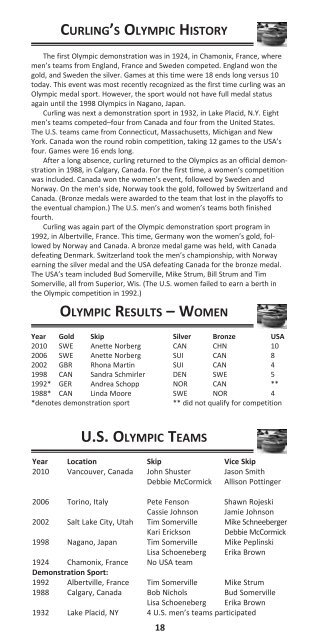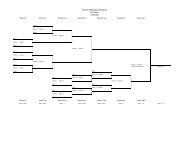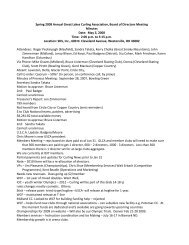USCA Media Guide - Great Lakes Curling Association
USCA Media Guide - Great Lakes Curling Association
USCA Media Guide - Great Lakes Curling Association
You also want an ePaper? Increase the reach of your titles
YUMPU automatically turns print PDFs into web optimized ePapers that Google loves.
CURlInG’s OlYMPIC hIsTORY<br />
The first Olympic demonstration was in 1924, in Chamonix, France, where<br />
men’s teams from England, France and Sweden competed. England won the<br />
gold, and Sweden the silver. Games at this time were 18 ends long versus 10<br />
today. This event was most recently recognized as the first time curling was an<br />
Olympic medal sport. However, the sport would not have full medal status<br />
again until the 1998 Olympics in Nagano, Japan.<br />
<strong>Curling</strong> was next a demonstration sport in 1932, in Lake Placid, N.Y. Eight<br />
men’s teams competed–four from Canada and four from the United States.<br />
The U.S. teams came from Connecticut, Massachusetts, Michigan and New<br />
York. Canada won the round robin competition, taking 12 games to the USA’s<br />
four. Games were 16 ends long.<br />
After a long absence, curling returned to the Olympics as an official demonstration<br />
in 1988, in Calgary, Canada. For the first time, a women’s competition<br />
was included. Canada won the women’s event, followed by Sweden and<br />
Norway. On the men’s side, Norway took the gold, followed by Switzerland and<br />
Canada. (Bronze medals were awarded to the team that lost in the playoffs to<br />
the eventual champion.) The U.S. men’s and women’s teams both finished<br />
fourth.<br />
<strong>Curling</strong> was again part of the Olympic demonstration sport program in<br />
1992, in Albertville, France. This time, Germany won the women’s gold, followed<br />
by Norway and Canada. A bronze medal game was held, with Canada<br />
defeating Denmark. Switzerland took the men’s championship, with Norway<br />
earning the silver medal and the USA defeating Canada for the bronze medal.<br />
The USA’s team included Bud Somerville, Mike Strum, Bill Strum and Tim<br />
Somerville, all from Superior, Wis. (The U.S. women failed to earn a berth in<br />
the Olympic competition in 1992.)<br />
OlYMPIC REsUlTs –WOMEn<br />
Year Gold skip silver bronze UsA<br />
2010 SWE Anette Norberg CAN CHN 10<br />
2006 SWE Anette Norberg SUI CAN 8<br />
2002 GBR Rhona Martin SUI CAN 4<br />
1998 CAN Sandra Schmirler DEN SWE 5<br />
1992* GER Andrea Schopp NOR CAN **<br />
1988* CAN Linda Moore SWE NOR 4<br />
*denotes demonstration sport<br />
** did not qualify for competition<br />
U.s. OlYMPIC TEAMs<br />
Year location skip vice skip<br />
2010 Vancouver, Canada John Shuster Jason Smith<br />
Debbie McCormick Allison Pottinger<br />
2006 Torino, Italy Pete Fenson Shawn Rojeski<br />
Cassie Johnson Jamie Johnson<br />
2002 Salt Lake City, Utah Tim Somerville Mike Schneeberger<br />
Kari Erickson Debbie McCormick<br />
1998 Nagano, Japan Tim Somerville Mike Peplinski<br />
Lisa Schoeneberg Erika Brown<br />
1924 Chamonix, France No USA team<br />
Demonstration sport:<br />
1992 Albertville, France Tim Somerville Mike Strum<br />
1988 Calgary, Canada Bob Nichols Bud Somerville<br />
Lisa Schoeneberg Erika Brown<br />
1932 Lake Placid, NY 4 U.S. men’s teams participated<br />
18





